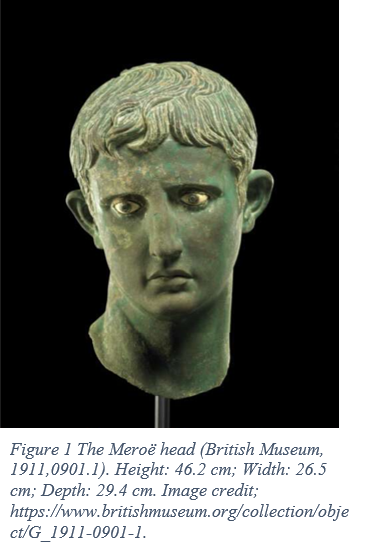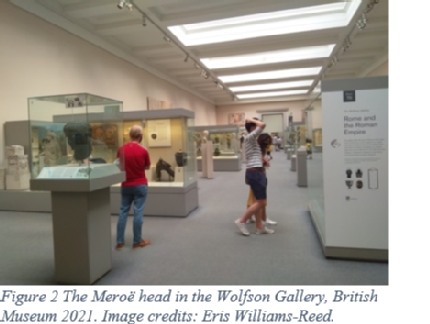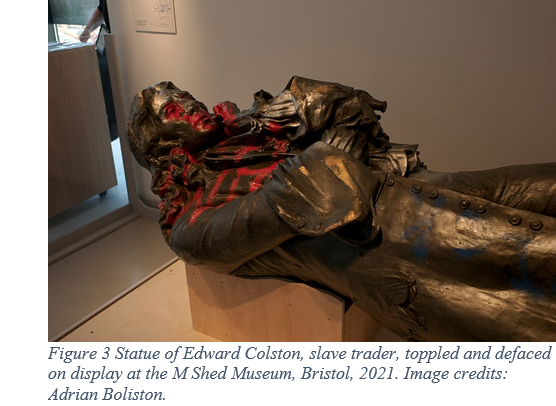Black voices, Black history, and the Meroë head - Áine Nikookam
The summer of 2020 sparked a big change in public debate surrounding British history and its ties to slavery and the monuments that mark that phase in the country’s history. Some recognised the atrocities of the past and called for new ways to recover Black voices and celebrate their history, with defacing and toppling statues of former slave owners being amongst the many ways to manifest this. However, what on earth does this have to do with a bronze head of Augustus found in the ancient city, Meroë?

Youthful, graceful, and divine are the words that can only describe how the statue looks, in a timeless 5th century BCE Classical style, but made in the 1st century BCE. Made from bronze, the statue would have demanded the gaze of others, illuminated in the shining, hot African sun, standing determined and constantly watching his subjects below. This symbol of power is further manifested through his slight frown, dynamic posture and, most importantly, his extremely realistic eyes. The innovation consists of the whites of the eyes made from white limestone, with the irises and pupils made from bronze and copper rings. What makes the finished look so realistic, however, is the glass paste, as it provides the sheen, wet look that resembles the eyes of humans. The attentive gaze the statue possesses holds the onlookers and walkers-by in a trance, seemingly a reminder that Augustus is observing and examining their every move under his careful watch. It is disturbing to look at when remembering how the statue would be distributed as widely as the boundaries of the empire and on public display. Statues would have stood feet above their subjects, with an expectation for Emperor Augustus’ rule to be quickly accepted as the ‘new normal’.
The toppling of this statue of Augustus perfectly conveyed the political message of changing power dynamics in the Nubian Kingdom of Kush, who demanded to be heard. The ancient kingdom, located in modern-day northern Sudan and southern Egypt, tactically used the Romans’ momentary distraction with the rebellion in Upper Egypt following a failed Roman expedition 26-25 BCE to their advantage. Soon after attacking Roman cohorts left at the Egyptian cities Syene, Elephantine, and Philae, they captured them, leading to Strabo, a Greek geographer and historian of the time, documenting how the Kushites tore down statues of Emperor Augustus (Strabo Geography 17.1.54). It is believed that the head came from one of those statues and was then buried under the steps to a temple of Victory in Meroë, the capital city of Nubia and the city from which the head got its name. I believe this to have been the Kushites’ way of candidly voicing their independence from Rome, and ritualistically humiliating Augustus, a symbol of the Roman Empire, as they stepped on his head each time they entered and left the temple.
However, this sign of triumph is tough to attribute to the Kushites, with narratives being difficult to find in, both, the ancient and modern worlds. In antiquity, the Kushites were labelled by Graeco-Roman authors as “Aithiopian”. The term came from the Greek words ‘aithō’ meaning ‘to burn’, and ‘ops’ which means ‘face’. Together it means ‘burnt face’. Aithiopia was the ‘land of the burnt faced people’. It was, undoubtedly, a racial slur used in works such as Herodotus’ Persian Wars, Strabo’s Geography, and even Augustus’ Res Gestae. The Kushites are also occasionally called “barbarian tribesmen” (Elsner 2019: 79) in modern-day scholarship. As Nubian culture is not studied as popularly as the Romans or Greeks, it would be easy to assume from sources such as those that the Nubians are violent, uncivilised, and primitive. It denies the Kushites the right to be seen as a thriving civilisation that greatly interacted with neighbouring empires, rich with unique customs and traditions.
--------
The Meroë head’s story, however, does not end there. The Kushites act of defiance perfectly preserved the head until its excavation in Sudan, 1910. The excavation was funded by the British archaeologist and professor John Garstang of Liverpool University. The head was found face down in a clean pocket of sand by a Sudanese worker, which further establishes that the head was intentionally buried as an insult. The photographs taken during the Nubian excavations depict the head’s discovery. One image depicts Garstang (far right) with his wife (seated) and other figures listed in the caption to the image’s

right.1 The two Sudanese individuals in the top right, however, are unnamed and undocumented. This is because the names of the Sudanese workers were not recorded – the only documented names were those of the ‘important’ figures of the time. If it was not for this photo, these individuals would have been erased from history. Hence, the Sudanese workers were discredited and ignored, with no written record or appreciation for the work they have done.
Currently, the Meroë head resides in the British Museum in Gallery 70 – ‘Rome and the Roman Empire’ – as a portrait of Augustus that symbolises the empire’s power. The head is seen as you first walk in from the Etruscan Gallery (room 71), at eye level and isolated in glass casing. The panel containing the curator’s comments only briefly mentions where the head was found and the meaning behind it but does not mention the position in which it was found. It emphasises the Roman aspect of the head and censors the idea that it symbolised Kushite resilience. Additionally, its upright position completely neglects the reasoning behind the initial placement of the head. The Meroë head is plunder, and the failure to represent the head as a trophy for the Kushite victory against the Romans shows how the display is not indicative to Kushite history.
 The change in perspective in the display of Edward Colston’s statue serves as a perfect differentiation as to how a toppled statue can manifest a completely different, yet powerful message. Edward Colston was a slave trader whose statue was toppled during a Black Lives Matter protest in Bristol, 7th June 2020. The statue was then defaced with graffiti before being thrown into the city’s harbour. Once recovered, the Bristolians decided to display the statue in the M Shed Museum, still toppled with the graffiti intact. Displaying the statue in its toppled state demonstrates the powerful way one can voice the different histories surrounding the statue and the figure it represents. Likewise, if we display the Meroë head in its toppled state, whether shown in a pocket of sand or under stairs just as the Kushites intended, we would be recognising the statue’s significance to the Kushites and celebrate a key moment in their history. The Kushites repurposed the head to represent their disrespect towards the Roman empire, not to commend the Romans on their expansion. By displaying the Meroë head as the Kushites intended, we have an opportunity to reflect on this object’s history and create a space in which we can discuss the many stories woven into the history of this statue.
The change in perspective in the display of Edward Colston’s statue serves as a perfect differentiation as to how a toppled statue can manifest a completely different, yet powerful message. Edward Colston was a slave trader whose statue was toppled during a Black Lives Matter protest in Bristol, 7th June 2020. The statue was then defaced with graffiti before being thrown into the city’s harbour. Once recovered, the Bristolians decided to display the statue in the M Shed Museum, still toppled with the graffiti intact. Displaying the statue in its toppled state demonstrates the powerful way one can voice the different histories surrounding the statue and the figure it represents. Likewise, if we display the Meroë head in its toppled state, whether shown in a pocket of sand or under stairs just as the Kushites intended, we would be recognising the statue’s significance to the Kushites and celebrate a key moment in their history. The Kushites repurposed the head to represent their disrespect towards the Roman empire, not to commend the Romans on their expansion. By displaying the Meroë head as the Kushites intended, we have an opportunity to reflect on this object’s history and create a space in which we can discuss the many stories woven into the history of this statue.
Bibliography
Ballantyne, T. (2021), ‘Toppling the Past?: Statues, Public Memory and the Afterlife of Empire in Contemporary New Zealand’, UTS ePRESS, vol.28, pp.1-8 [Accessed online 14 July 2021] Available at: https://epress.lib.uts.edu.au/index.php/phrj/article/view/7503.
Elsner, J. (2019), ‘Concealment and Revelation; The Pola casket and the Visuality of Early Christian Relics’, Conditions of Visibility, (eds. Neer, R.), (Oxford: Oxford University Press).
Garstang Museum of Archaeology (2016), ‘Sands of time: ancient Egypt excavated in the 1910s – in pictures’, The Guardian, [Accessed online 16 July 2021] Available at: https://www.theguardian.com/artanddesign/gallery/2016/jun/15/sands-of-time-ancient-egypt-excavated-in-pictures
Liddell, H.G., Scott, R. (1940), A Greek-English Lexicon, (Oxford; Clarendon Press) [Accessed online 16 July 2021] Available at: https://www.perseus.tufts.edu/hopper/text?doc=Perseus%3Atext%3A1999.04.0057%3Aentry%3D%232329&redirect=true
Matić ,U. (2014), ‘Headhunting on the Roman Frontier: (Dis)respect, mockery, magic and the head of Augustus from Meroe’, The Edges of the Roman World, (eds. Janković, M. A., Mihajlović, V. D., and Babić, S.), (Cambridge Scholars Publishing; Newcastle upon Tyne), pp.117-134.
Morris, S. (2021), ‘Statue of slave trader Edward Colston to go on display in Bristol Museum’, The Guardian, 28 May 2021, [Accessed Online July 16] Available at: https://www.theguardian.com/uk-news/2021/may/28/statue-of-slave-trader-edward-colston-to-go-on-display-in-bristol-museum
Strabo (trans. H. L. Jones) (1932), Geography; Volume VIII, (Harvard University Press; Cambridge).
Zhang, A. (2020), ‘Damnatio Memoriae and Black Lives Matter’, Stanford Law Review Online, vol.73, pp.77-88.
Table of Figures
